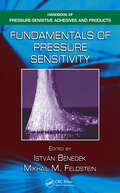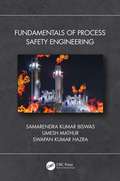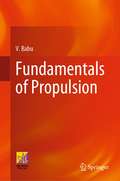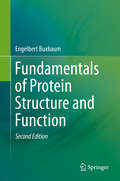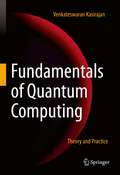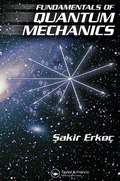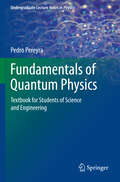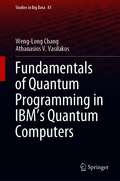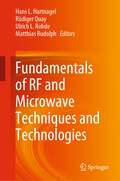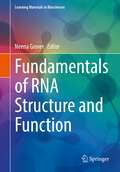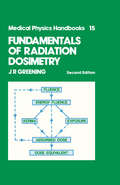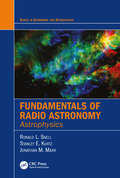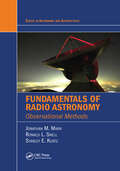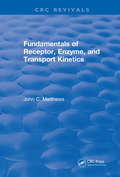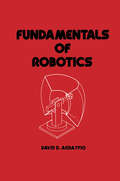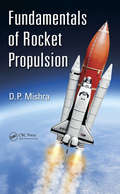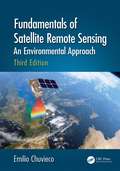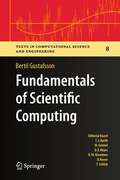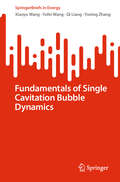- Table View
- List View
Fundamentals of Pressure Sensitivity (Handbook of Pressure-Sensitive Adhesives and Products)
by Mikhail M. Feldstein István BenedekDiscussing the definition of pressure sensitivity and characterization of pressure-sensitive behavior, Volume 1 of the Handbook of Pressure-Sensitive Adhesives and Products presents the underlying theory beh
Fundamentals of Process Safety Engineering
by Samarendra Kumar Biswas Umesh Mathur Swapan Kumar HazraThis textbook covers the essential aspects of process safety engineering in a practical and comprehensive manner. It provides readers with an understanding of process safety hazards in the refining and petrochemical industries and how to manage them in a reliable and professional manner. It covers the most important concepts: static electricity, intensity of thermal radiation, thermodynamics of fluid phase equilibria, boiling liquid expanding vapor explosion (BLEVE), emission source models, hazard identification methods, risk control and methods for achieving manufacturing excellence while also focusing on safety. Extensive case studies are included. Aimed at senior undergraduate and graduate chemical engineering students and practicing engineers, this book covers process safety principles and engineering practice authoritatively, with comprehensive examples: • Fundamentals, methods, and procedures for the industrial practice of process safety engineering.• The thermodynamic fundamentals and computational methods for release rates from ruptures in pipelines, vessels, and relief valves.• Fundamentals of static electricity hazards and their mitigation.• Quantitative assessment of fires and explosions.• Principles of dispersion calculations for toxic or flammable gases and vapors.• Methods of qualitative and quantitative risk assessment and control.
Fundamentals of Propulsion
by V. BabuThis highly informative book offers a comprehensive overview of the fundamentals of propulsion. The book focuses on foundational topics in propulsion, namely gas dynamics, turbomachinery, and combustion to more complex subjects such as practical design aspects of aircraft engines and thermodynamic aspects and analysis. It also includes pedagogical aspects such as end-of-chapter problems and worked examples to augment learning and self-testing. This book is a useful reference for students in the area of mechanical and aerospace engineering. Also, scientists and engineers working in the areas of aerospace propulsion and gas dynamics find this book a valuable addition.^
Fundamentals of Protein Biotechnology (Biotechnology And Bioprocessing Ser. #7)
by SteinFills a gap between the existing studies of proteins, which tend to be highly technical and geared toward the practicing protein chemist, and biochemistry textbooks, which focus on general principles. Scientists cover a dozen topics by presenting fundamental principles, an overview, and the practica
Fundamentals of Protein Structure and Function
by Engelbert BuxbaumThis book serves as an introduction to protein structure and function. Starting with their makeup from simple building blocks, called amino acids, the 3-dimensional structure of proteins is explained. This leads to a discussion how misfolding of proteins causes diseases like cancer, various encephalopathies, or diabetes. Enzymology and modern concepts of enzyme kinetics are then introduced, taking into account the physiological, pharmacological and medical significance of this often neglected topic. This is followed by thorough coverage of hæmoglobin and myoglobin, immunoproteins, motor proteins and movement, cell-cell interactions, molecular chaperones and chaperonins, transport of proteins to various cell compartments and solute transport across biological membranes. Proteins in the laboratory are also covered, including a detailed description of the purification and determination of proteins, as well as their characterisation for size and shape, structure and molecular interactions. The book emphasises the link between protein structure, physiological function and medical significance. This book can be used for graduate and advanced undergraduate classes covering protein structure and function and as an introductory text for researchers in protein biochemistry, molecular and cell biology, chemistry, biophysics, biomedicine and related courses. About the author: Dr. Buxbaum is a biochemist with interest in enzymology and protein science. He has been working on the biochemistry of membrane transport proteins for nearly thirty years and has taught courses in biochemistry and biomedicine at several universities.
Fundamentals of Psychiatry for Health Care Professionals
by Cristina Colombo Roberto CavallaroThe book provides all the relevant information to understand the mental illness through psychopathology, global clinical manifestations and clinical patterns. It equips the reader with the basic knowledge to identify psychiatric conditions occurring alone or in the context of other medical illnesses, to distinguish health psychology and psychiatry, and to know what to do, how to do it, and how to communicate with the patient and to cooperate with the psychiatrist. The core chapters are dedicated to mental disorders diagnosed according to the DSM V, and are organized in sub-chapters with key feature boxes and schemes that will allow the global comprehension of the mental disorder and its clinical management. The work includes also a general chapter on psychopathology and one on psychopharmacology presenting the practical information about suggested doses, side effects, drug interactions and warnings for the main psychotropics. The final chapter deals with forensic and legal aspects. Fundamentals of Psychiatry for Health Care Professionals will appeal to a wide readership, from post graduate professionals who want to broaden their clinical knowledge of psychiatry to medical students and students of the health degree courses like Physiotherapy, Psychology, Nursing, or Dentistry.
Fundamentals of Quantum Computing: Theory and Practice
by Venkateswaran KasirajanThis introductory book on quantum computing includes an emphasis on the development of algorithms. Appropriate for both university students as well as software developers interested in programming a quantum computer, this practical approach to modern quantum computing takes the reader through the required background and up to the latest developments. Beginning with introductory chapters on the required math and quantum mechanics, Fundamentals of Quantum Computing proceeds to describe four leading qubit modalities and explains the core principles of quantum computing in detail. Providing a step-by-step derivation of math and source code, some of the well-known quantum algorithms are explained in simple ways so the reader can try them either on IBM Q or Microsoft QDK. The book also includes a chapter on adiabatic quantum computing and modern concepts such as topological quantum computing and surface codes.Features:o Foundational chapters that build the necessary background on math and quantum mechanics.o Examples and illustrations throughout provide a practical approach to quantum programming with end-of-chapter exercises.o Detailed treatment on four leading qubit modalities -- trapped-ion, superconducting transmons, topological qubits, and quantum dots -- teaches how qubits work so that readers can understand how quantum computers work under the hood and devise efficient algorithms and error correction codes. Also introduces protected qubits - 0-π qubits, fluxon parity protected qubits, and charge-parity protected qubits. o Principles of quantum computing, such as quantum superposition principle, quantum entanglement, quantum teleportation, no-cloning theorem, quantum parallelism, and quantum interference are explained in detail. A dedicated chapter on quantum algorithm explores both oracle-based, and Quantum Fourier Transform-based algorithms in detail with step-by-step math and working code that runs on IBM QisKit and Microsoft QDK. Topics on EPR Paradox, Quantum Key Distribution protocols, Density Matrix formalism, and Stabilizer formalism are intriguing. While focusing on the universal gate model of quantum computing, this book also introduces adiabatic quantum computing and quantum annealing.This book includes a section on fault-tolerant quantum computing to make the discussions complete. The topics on Quantum Error Correction, Surface codes such as Toric code and Planar code, and protected qubits help explain how fault tolerance can be built at the system level.
Fundamentals of Quantum Mechanics
by Sakir ErkocProviding a unified account of nonrelativistic quantum mechanics, Fundamentals of Quantum Mechanics covers the principles and formalism of quantum mechanics and the development and application of general techniques for the solution of quantum mechanical problems. The author has done everything possible to make the math in this book accessible.The b
Fundamentals of Quantum Physics
by Pedro PereyraThis book presents a comprehensive course of quantum mechanics for undergraduate and graduate students. After a brief outline of the innovative ideas that lead up to the quantum theory, the book reviews properties of the Schrödinger equation, the quantization phenomena and the physical meaning of wave functions. The book discusses, in a direct and intelligible style, topics of the standard quantum formalism like the dynamical operators and their expected values, the Heisenberg and matrix representation, the approximate methods, the Dirac notation, harmonic oscillator, angular momentum and hydrogen atom, the spin-field and spin-orbit interactions, identical particles and Bose-Einstein condensation etc. Special emphasis is devoted to study the tunneling phenomena, transmission coefficients, phase coherence, energy levels splitting and related phenomena, of interest for quantum devices and heterostructures. The discussion of these problems and the WKB approximation is done using the transfer matrix method, introduced at a tutorial level. This book is a textbook for upper undergraduate physics and electronic engineering students.
Fundamentals of Quantum Programming in IBM's Quantum Computers (Studies in Big Data #81)
by Athanasios V. Vasilakos Weng-Long ChangThis textbook introduces major topics that include quantum bits, superposition, entanglement, logic gates, quantum search algorithm, quantum Fourier transform, inverse quantum Fourier transform, Shor’s order-finding algorithm and phase estimation. Everyone can write algorithms and programs in the cloud making using IBM’s quantum computers that support IBM Q Experience which contains the composer, open quantum assembly language, simulators and real quantum devices. Furthermore, this book teaches you how to use open quantum assembly language to write quantum programs for dealing with complex problems. Through numerous examples and exercises, readers will learn how to write a quantum program with open quantum assembly language for solving any problem from start to complete. This book includes six main chapters: ·Quantum Bits and Quantum Gates—learn what quantum bits are, how to declare and measure them, what quantum gates are and how they work on a simulator or a real device in the cloud. ·Boolean Algebra and its Applications—learn how to decompose CCNOT gate into six CNOT gates and nine gates of one bit and how to use NOT gates, CNOT gates and CCNOT gates to implement logic operations including NOT, OR, AND, NOR, NAND, Exclusive-OR (XOR) and Exclusive-NOR (XNOR). ·Quantum Search Algorithm and its Applications—learn core concepts of quantum search algorithm and how to write quantum programs to implement core concepts of quantum search algorithm for solving two famous NP-complete problems that are the satisfiability problem in n Boolean variables and m clauses and the clique problem in a graph with n vertices and q edges. ·Quantum Fourier Transform and its Applications—learn core concepts of quantum Fourier transform and inverse quantum Fourier transform and how to write quantum programs to implement them for solving two real applications that are to compute the period and the frequency of two given oracular functions. ·Order-Finding and Factoring—learn core concepts of Shor’s order-finding algorithm and how to write quantum programs to implement Shor’s order-finding algorithm for completing the prime factorization to 15. Phase Estimation and its Applications—learn core concepts of phase estimation and quantum counting and how to write quantum programs to implement them to compute the number of solution(s) in the independent set problem in a graph with two vertices and one edge.
Fundamentals of RF and Microwave Techniques and Technologies
by Ulrich L. Rohde Matthias Rudolph Hans L. Hartnagel Rüdiger QuayThe increase of consumer, medical and sensors electronics using radio frequency (RF) and microwave (MW) circuits has implications on overall performances if design is not robust and optimized for a given applications. The current and later generation communication systems and Internet of Thing (IoT) demand for robust electronic circuits with optimized performance and functionality, but low cost, size, and power consumption. As a result, there is a need for a textbook that provides a comprehensive treatment of the subject. This book provides state-of-the-art coverage of RF and Microwave Techniques and Technologies, covers important topics: transmission-line theory, passive and semiconductor devices, active and passive microwave circuits and receiver systems, as well as antennas, noise and digital signal modulation schemes. With an emphasis on theory, design, and applications, this book is targeted to students, teachers, scientists, and practicing design engineers who are interested in broadening their knowledge of RF and microwave electronic circuit design. Readers will also benefit from a unique integration of theory and practice, provides the readers a solid understanding of the RF and microwave concepts, active and passive components, antenna, and modulation schemes. Readers will learn to solve common design problems ranging from selection of components, matching networks to biasing and stability, and digital modulation techniques. More importantly, it provides basic understanding in the analysis and design of RF and microwave circuits in a manner that is practiced in industry. This make sure that the know-how learned in this book can be effortlessly and straightway put into practice without any obstacles.
Fundamentals of RNA Structure and Function (Learning Materials in Biosciences)
by Neena GroverThis highly illustrated textbook provides an essential overview on RNA architecture and function, it offers insights into the RNA basics and also explains novel RNA technologies, such as CRISPR-Cas and their applications. In addition, the mRNA based vaccine technology, which has long been tested, also before the COVID-19 pandemic, is discussed and students receive a basic understanding of this important medical application.The textbook is written by Prof. Grover in collaboration with her students and has an easily accessible style. The book provides a great tool for young researchers and students in biology, biomedical engineering or biochemistry, looking for a compact introduction or refresher work on RNA, including the newest findings and technologies. It is an ideal starter to learn about several RNA specific topics and to research them further.
Fundamentals of Radiation Dosimetry (Series in Medical Physics and Biomedical Engineering #Vol. 15)
by J.R GreeningThis book reviews ionising radiation quantities and the relationships between them and discusses the principles underlying their measurement. The emphasis is on the determination of absorbed dose and related dosimetric quantities.
Fundamentals of Radiation Materials Science
by Gary S. WasThe revised second edition of this established text offers readers a significantly expanded introduction to the effects of radiation on metals and alloys. It describes the various processes that occur when energetic particles strike a solid, inducing changes to the physical and mechanical properties of the material. Specifically it covers particle interaction with the metals and alloys used in nuclear reactor cores and hence subject to intense radiation fields. It describes the basics of particle-atom interaction for a range of particle types, the amount and spatial extent of the resulting radiation damage, the physical effects of irradiation and the changes in mechanical behavior of irradiated metals and alloys. Updated throughout, some major enhancements for the new edition include improved treatment of low- and intermediate-energy elastic collisions and stopping power, expanded sections on molecular dynamics and kinetic Monte Carlo methodologies describing collision cascade evolution, new treatment of the multi-frequency model of diffusion, numerous examples of RIS in austenitic and ferritic-martensitic alloys, expanded treatment of in-cascade defect clustering, cluster evolution, and cluster mobility, new discussion of void behavior near grain boundaries, a new section on ion beam assisted deposition, and reorganization of hardening, creep and fracture of irradiated materials (Chaps 12-14) to provide a smoother and more integrated transition between the topics. The book also contains two new chapters. Chapter 15 focuses on the fundamentals of corrosion and stress corrosion cracking, covering forms of corrosion, corrosion thermodynamics, corrosion kinetics, polarization theory, passivity, crevice corrosion, and stress corrosion cracking. Chapter 16 extends this treatment and considers the effects of irradiation on corrosion and environmentally assisted corrosion, including the effects of irradiation on water chemistry and the mechanisms of irradiation-induced stress corrosion cracking. The book maintains the previous style, concepts are developed systematically and quantitatively, supported by worked examples, references for further reading and end-of-chapter problem sets. Aimed primarily at students of materials sciences and nuclear engineering, the book will also provide a valuable resource for academic and industrial research professionals. Reviews of the first edition: ". . . nomenclature, problems and separate bibliography at the end of each chapter allow to the reader to reach a straightforward understanding of the subject, part by part. . . . this book is very pleasant to read, well documented and can be seen as a very good introduction to the effects of irradiation on matter, or as a good references compilation for experimented readers. " - Pauly Nicolas, Physicalia Magazine, Vol. 30 (1), 2008 "The text provides enough fundamental material to explain the science and theory behind radiation effects in solids, but is also written at a high enough level to be useful for professional scientists. Its organization suits a graduate level materials or nuclear science course. . . the text was written by a noted expert and active researcher in the field of radiation effects in metals, the selection and organization of the material is excellent. . . may well become a necessary reference for graduate students and researchers in radiation materials science. " - L. M. Dougherty, 07/11/2008, JOM, the Member Journal of The Minerals, Metals and Materials Society.
Fundamentals of Radio Astronomy: Astrophysics (Series in Astronomy and Astrophysics)
by Stanley Kurtz Ronald L. Snell Jonathan MarrAs demonstrated by five Nobel Prizes in physics, radio astronomy has contributed greatly to our understanding of the Universe. Courses covering this subject are, therefore, very important in the education of the next generation of scientists who will continue to explore the Cosmos. This textbook, the second of two volumes, presents an extensive introduction to the astrophysical processes that are studied in radio astronomy. Suitable for undergraduate courses on radio astronomy, it discusses the physical phenomena that give rise to radio emissions, presenting examples of astronomical objects, and illustrating how the relevant physical parameters of astronomical sources can be obtained from radio observations. Unlike other radio astronomy textbooks, this book provides students with an understanding of the background and the underlying principles, with derivations available for most of the equations used in the textbook. Features: Presents a clear and concise discussion of the important astronomical concepts and physical processes that give rise to both radio continuum and radio spectral line emission Discusses radio emissions from a variety of astronomical sources and shows how the observed emissions can be used to derive the physical properties of these sources Includes numerous examples using actual data from the literature
Fundamentals of Radio Astronomy: Observational Methods (Series in Astronomy and Astrophysics)
by Jonathan M. Marr Ronald L. Snell Stanley E. KurtzAs evidenced by five Nobel Prizes in physics, radio astronomy in its 80-year history has contributed greatly to our understanding of the universe. Yet for too long, there has been no suitable textbook on radio astronomy for undergraduate students.Fundamentals of Radio Astronomy: Observational Methods is the first undergraduate-level textbook exclus
Fundamentals of Radiochemistry
by Jean-Pierre AdloffFundamentals of Radiochemistry presents a comprehensive overview of the principles, objectives, and methods of radiochemistry and how they are applied in various fields of chemistry. Topics covered include characteristics of radioactivity and radioactive matter, the chemistry of ephemeral radionuclides, actinides of high atomic number, positronium, and physicochemical behavior of systems containing one or more compounds at tracer or sub-tracer concentration. Numerous appendices are included to provide additional detail to information presented in chapters. Because Fundamentals of Radiochemistry is the first book to discuss what chemical information can be obtained with sub-tracer amounts, it is essential reading for inorganic chemists, radiochemists, analytical chemists, nuclear chemists and others interested in the topic.
Fundamentals of Receptor, Enzyme, and Transport Kinetics (CRC Press Revivals)
by John C. MatthewsFundamentals of Receptor, Enzyme, and Transport Kinetics is the first book to pull together the most important topics in receptor, enzyme, and transport kinetics into a concise, easy-to-use format. Numerous equations are included, and key equations are graphed. For each graphed equation, important features are carefully explained. The book is organized so that simple material is presented first, providing a firm foundation on which to cover the advanced topics which appear later. Terminology used throughout the book is consistent with that used in scientific literature, and concepts are explained using analogies from daily life. The book also features two important appendices that will be particularly useful learning tools. The first appendix outlines all of the key equations from the text and indicates their use. The second appendix is a set of sample calculation problems and their solutions. Fundamentals of Receptor, Enzyme, and Transport Kinetics is an excellent text/reference for pharmacologists, biological chemists, experimental biologists, neurochemists, neurotoxicologists, physiologists, and toxicologists. It is also suitable as a graduate-level text in pharmacology and medical pharmacology.
Fundamentals of Recovery, Regeneration, and Adaptation to Exercise Stress: An Integrated Approach
by Nikos C. Apostolopoulos Gregory C. Bogdanis Loren R. Seagrave Michael J. PlyleyThis volume explores adaptation, recovery, and regeneration, including training foundations, and the issue of tissue damage during physical activity – from basic and applied science perspective, and clinical/practitioner viewpoint. The chapters examine our current understanding of the etiology of tissue damage, and explore current therapy techniques to remediate tissue damage post-injury, as well as strategies to minimize the occurrence of injury through proper preparation. The book employs a multidisciplinary approach to study how to best translate, utilize, and communicate the knowledge developed from current research into actual practice. In addition, the book presents a crucial perspective on how current practice should voice issues and questions to fuel further research in the field. This material will be useful for upper undergraduate degree programs, as well as post graduate programs in kinesiology, physical therapy, occupational therapy, bio-engineering and other health sciences. It is also a good reference for practitioners and researchers in fields involving musculoskeletal heath and sports medicine, and who are interested in the area of tissue adaptation, recovery, and regeneration.
Fundamentals of Robotics
by David ArdayfioFundamentals of Robotics presents the basic concepts of robots to engineering and technology students and to practicing engineers who want to grasp the fundamentals in the growing field of robotics.
Fundamentals of Rocket Propulsion
by D. P. Mishra<p>The book follows a unified approach to present the basic principles of rocket propulsion in concise and lucid form. This textbook comprises of ten chapters ranging from brief introduction and elements of rocket propulsion, aerothermodynamics to solid, liquid and hybrid propellant rocket engines with chapter on electrical propulsion. Worked out examples are also provided at the end of chapter for understanding uncertainty analysis. <p>This book is designed and developed as an introductory text on the fundamental aspects of rocket propulsion for both undergraduate and graduate students. It is also aimed towards practicing engineers in the field of space engineering. This comprehensive guide also provides adequate problems for audience to understand intricate aspects of rocket propulsion enabling them to design and develop rocket engines for peaceful purposes.</p>
Fundamentals of Satellite Remote Sensing: An Environmental Approach, Third Edition
by Emilio ChuviecoFundamentals of Satellite Remote Sensing: An Environmental Approach, Third Edition, is a definitive guide to remote sensing systems that focuses on satellite-based remote sensing tools and methods for space-based Earth observation (EO). It presents the advantages of using remote sensing data for studying and monitoring the planet, and emphasizes concepts that make the best use of satellite data. The book begins with an introduction to the basic processes that ensure the acquisition of space-borne imagery, and provides an overview of the main satellite observation systems. It then describes visual and digital image analysis, highlights various interpretation techniques, and outlines their applications to science and management. The latter part of the book covers the integration of remote sensing with Geographic Information System (GIS) for environmental analysis. This latest edition has been written to reflect a global audience and covers the most recent advances incorporated since the publication of the previous book, relating to the acquisition and interpretation of remotely sensed data. New in the Third Edition: Includes additional illustrations in full color. Uses sample images acquired from different ecosystems at different spatial resolutions to illustrate different interpretation techniques. Includes updated EO missions, such as the third generations of geostationary meteorological satellites, the new polar orbiting platforms (Suomi), the ESA Sentinels program, and high-resolution commercial systems. Includes extended coverage of radar and LIDAR processing methods. Includes all new information on near-ground missions, including unmanned aerial vehicles (UAVs). Covers new ground sensors, as well as machine-learning approaches to classification. Adds more focus on land surface characterization, time series, change detection, and ecosystem processes. Extends the interactions of EO data and GIS that cover different environmental problems, with particular relevance to global observation. Fundamentals of Satellite Remote Sensing: An Environmental Approach, Third Edition, details the tools that provide global, recurrent, and comprehensive views of the processes affecting the Earth. As one of CRC’s Essential titles, this book and stands out as one of the best in its field and is a must-have for researchers, academics, students, and professionals involved in the field of environmental science, as well as for libraries developing collections on the forefront of this industry.
Fundamentals of Scientific Computing
by Bertil GustafssonThe book of nature is written in the language of mathematics -- Galileo Galilei How is it possible to predict weather patterns for tomorrow, with access solely to today's weather data? And how is it possible to predict the aerodynamic behavior of an aircraft that has yet to be built? The answer is computer simulations based on mathematical models - sets of equations - that describe the underlying physical properties. However, these equations are usually much too complicated to solve, either by the smartest mathematician or the largest supercomputer. This problem is overcome by constructing an approximation: a numerical model with a simpler structure can be translated into a program that tells the computer how to carry out the simulation. This book conveys the fundamentals of mathematical models, numerical methods and algorithms. Opening with a tutorial on mathematical models and analysis, it proceeds to introduce the most important classes of numerical methods, with finite element, finite difference and spectral methods as central tools. The concluding section describes applications in physics and engineering, including wave propagation, heat conduction and fluid dynamics. Also covered are the principles of computers and programming, including MATLAB®.
Fundamentals of Shallow Water Acoustics
by James Lynch Boris Katsnelson Valery PetnikovShallow water acoustics (SWA), the study of how low and medium frequency sound propagates and scatters on the continental shelves of the worlds oceans, has both technical interest and a large number of practical applications. Technically, shallow water poses an interesting medium for the study of acoustic scattering, inverse theory, and propagation physics in a complicated oceanic waveguide. Practically, shallow water acoustics has interest for geophysical exploration, marine mammal studies, and naval applications. Additionally, one notes the very interdisciplinary nature of shallow water acoustics, including acoustical physics, physical oceanography, marine geology, and marine biology. In this specialized volume the authors, all of whom have extensive at-sea experience in US and Russian research efforts, have tried to summarize the main experimental, theoretical, and computational results in shallow water acoustics, with an emphasis on providing physical insight into the topics presented.
Fundamentals of Single Cavitation Bubble Dynamics (SpringerBriefs in Energy)
by Xiaoyu Wang Yuning Zhang Qi Liang Yufei WangThis brief provides a comprehensive review of the rapidly expanding field of cavitation and bubble dynamics, covering the discussion of bubble dynamics equations, bubble oscillation dynamics, theoretical prediction models of jets, and high-speed photography technology. Among them, the core formulas, important research methods, and typical results related to bubble oscillation and collapse dynamics are systematically and comprehensively introduced. Specifically, in terms of the bubble dynamics equations, several classical dynamic equations utilized to describe the radial motion of the spherical bubble, cylindrical bubble, and the bubble in a droplet are derived and compared. In terms of the bubble oscillation dynamics, based on the perturbation method, multi-scale method, and Laplace transform method, the nonlinear oscillation characteristics of the bubble in free oscillation and driven oscillation are analyzed. In terms of the jet prediction theory, the Kelvin impulse model and various boundary treatment methods are given in detail, and the jet direction, intensity, and spatial sensitivity caused by the bubble collapse near various boundaries are discussed. In terms of the bubble collapse visualization based on the high-speed photography, taking the laser-induced bubble as an example, the system composition, operation process and experimental layout of the high-speed photography experimental platform are introduced, and a large number of typical bubble collapse deformation, jet evolution and shock wave propagation characteristics obtained from experiments are demonstrated. This book is intended for academic researchers and graduate students in fluid dynamics, aiming to consolidate the basic theory, physical mechanism, and latest progress in the field of bubble dynamics.
